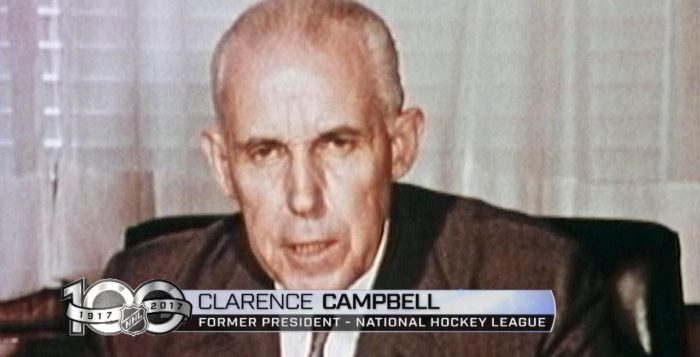This Day in Hockey History – September 4, 1946 – Campbell Reaches the Highland
The succession was not supposed to happen so quickly, but World War II changed everything. When the President of the NHL resigned in a bit of snit, Clarence S. Campbell was announced as the new president on September 4, 1946.
Campbell’s primary profession had been that of a lawyer. However, he did work as an NHL referee between 1936 and 1940 (until Toronto’s Conn Smythe called for his removal). Although the NHL decided not to rehire Campbell as a referee, President Frank Calder invited him to work in his office and began grooming him in administration. The war paused Campbell’s career trajectory as he enlisted in the Canadian Army. He served for six years, during which time he received the Order of the British Empire, worked with the No. 1 Canadian War Graves Investigation Unit, and prosecuted at least one Nazi leader for war crimes. Upon returning from the war, Campbell became the assistant to Mervyn “Red” Dutton.
When Calder died suddenly, in May 1943, Dutton had been elected as the President of the NHL. It seemed that he really did not want the job since he tried to resign a few times. Despite signing a five-year contract in 1945, Dutton took advantage of Campbell’s return to step aside. He claimed, “I’m tired out. I haven’t had much home life and I’ve missed it. I want to drop anchor for a while.” The press cited “the increasing pressure of business interests,” like his construction company in Calgary.
In reality, Dutton’s departure had more to do with bitterness. Part of his agreement to preside over the NHL had concerned reviving the Americans franchise in Brooklyn once the war ended. They questioned whether that region could support yet another team, and Dutton had difficulties with financing and constructing an arena. He resigned when they denied his franchise request, but he recommended Campbell as his replacement.
At the semi-annual meeting at the Windsor Hotel in Montreal, the NHL approved Campbell as the new president. Despite whatever hard feelings he may have had, Dutton commented, “But I must say the governors gave me fine cooperation as head of the league. The press did, too, and I’m grateful for it. If they support Clarence Campbell the same way he’ll do a good job.”
In the official press statement, Campbell said: “Today’s developments were much more rapid than I had anticipated. It was my original understanding and my personal hope that Mervyn Dutton would have continued in the office of president for the ensuing year and at least for a few months. Like everyone else I appreciate how important it is for him to attend to his personal affairs at this time and I am very grateful to him for his expression of confidence that I should succeed him so rapidly and without any practical experience in administration of the National Hockey League. … In my new position I conceive it my duty to do everything possible to enhance its [hockey’s] prestige, not only in organized professional sport, but with the sporting public and the parents of the young hockey players, who will some day be the hockey greats.”
Campbell himself has been considered a hockey great. He served as president for 31 years, until his retirement on June 22, 1977. Over those three decades, he led the NHL in adding annual All-Star Games (beginning in 1947-48), increasing from 50 to 60 games (beginning in 1946-47) then 60 to 70 games each regular season (beginning in 1949-50), holding an annual amateur draft (beginning in 1963), and expanding to double the size (in 1967) and triple the size (by 1976).
Campbell was inducted into the Hockey Hall of Fame in 1966. With the first major expansion the following year, the NHL began awarding the Clarence S. Campbell Bowl to the winner of the Campbell Conference (which became the Western Conference as of 1993).
Additional Sources:
- Mike Commito, Hockey 365: Daily Stories from the Ice(Toronto: Dundurn, 2018), kindle edition.
- https://www.hhof.com/htmlSpotlight/spot_oneononeb196601.shtml
- https://thepinkpuck.com/2019/07/23/this-day-in-hockey-history-july-23-1897-a-red-letter-day/
- “Clarence Campbell Elected President of the N.H.L.” and ‘From War Trials to Presidency is Road of New League Head,” Montreal Gazette, 5 Sept. 1946, p. 12.
- Dink Carroll, “Playing the Field: Red Heads for Home,” Montreal Gazette, 6 Sept. 1946, p. 16.














